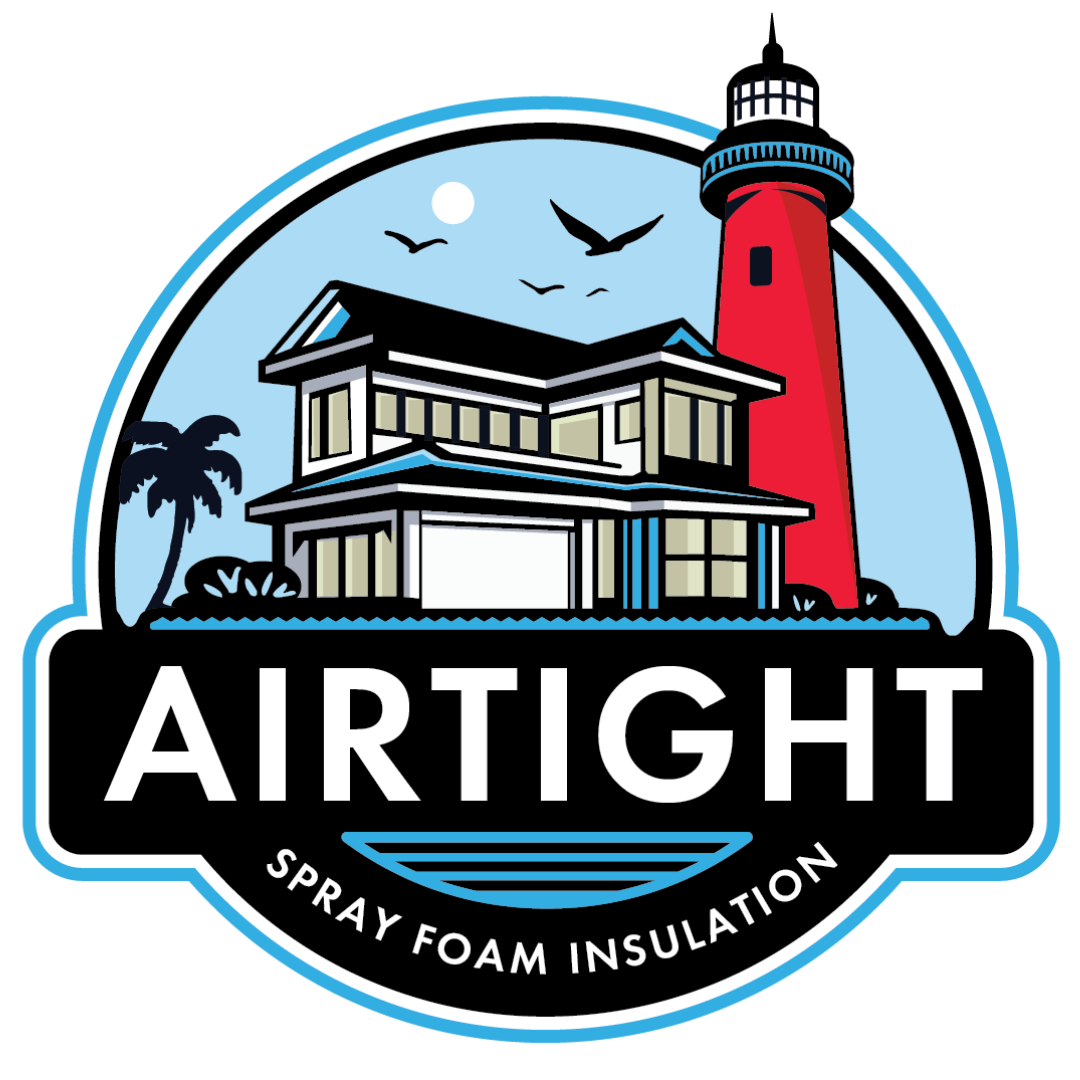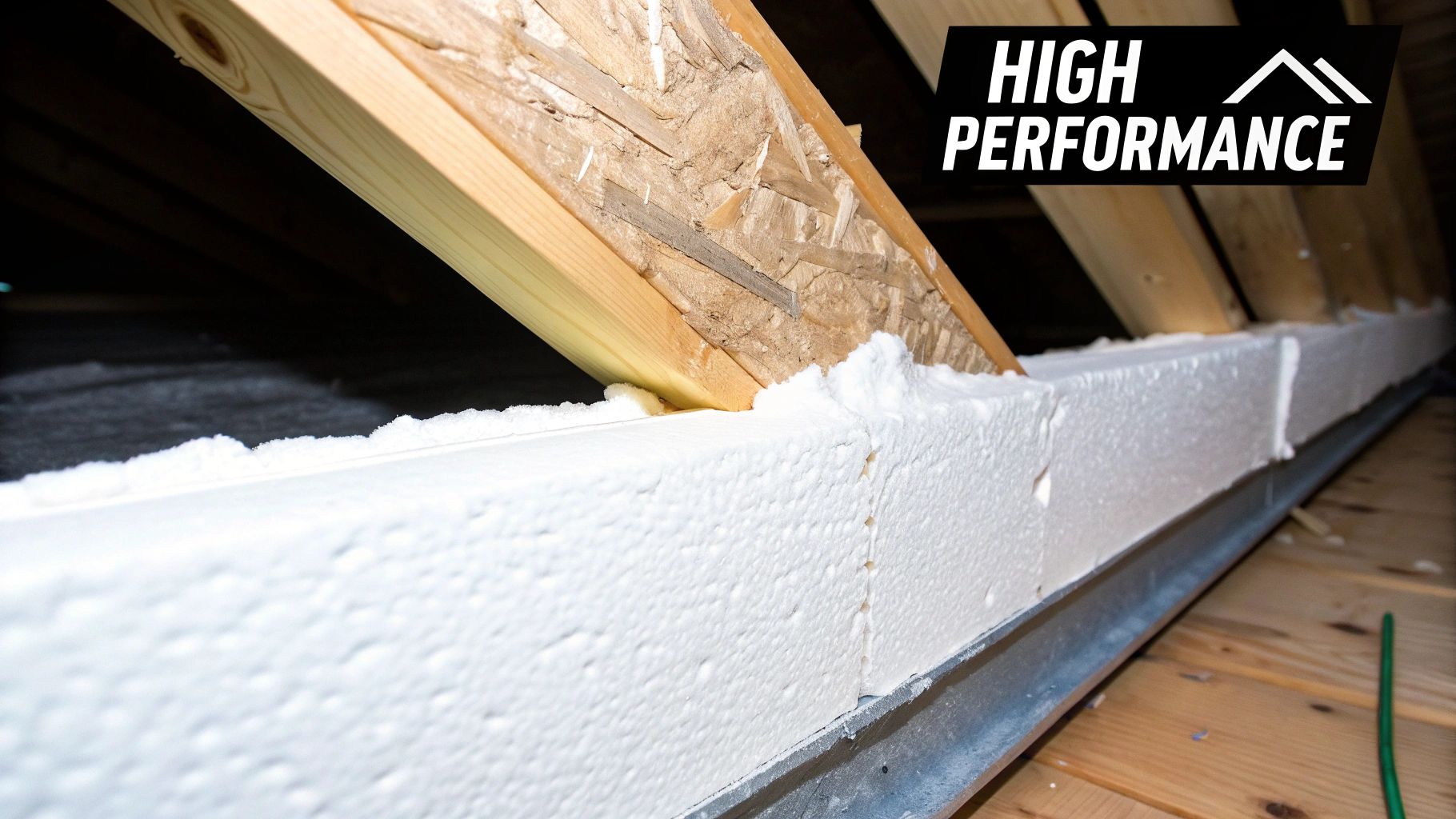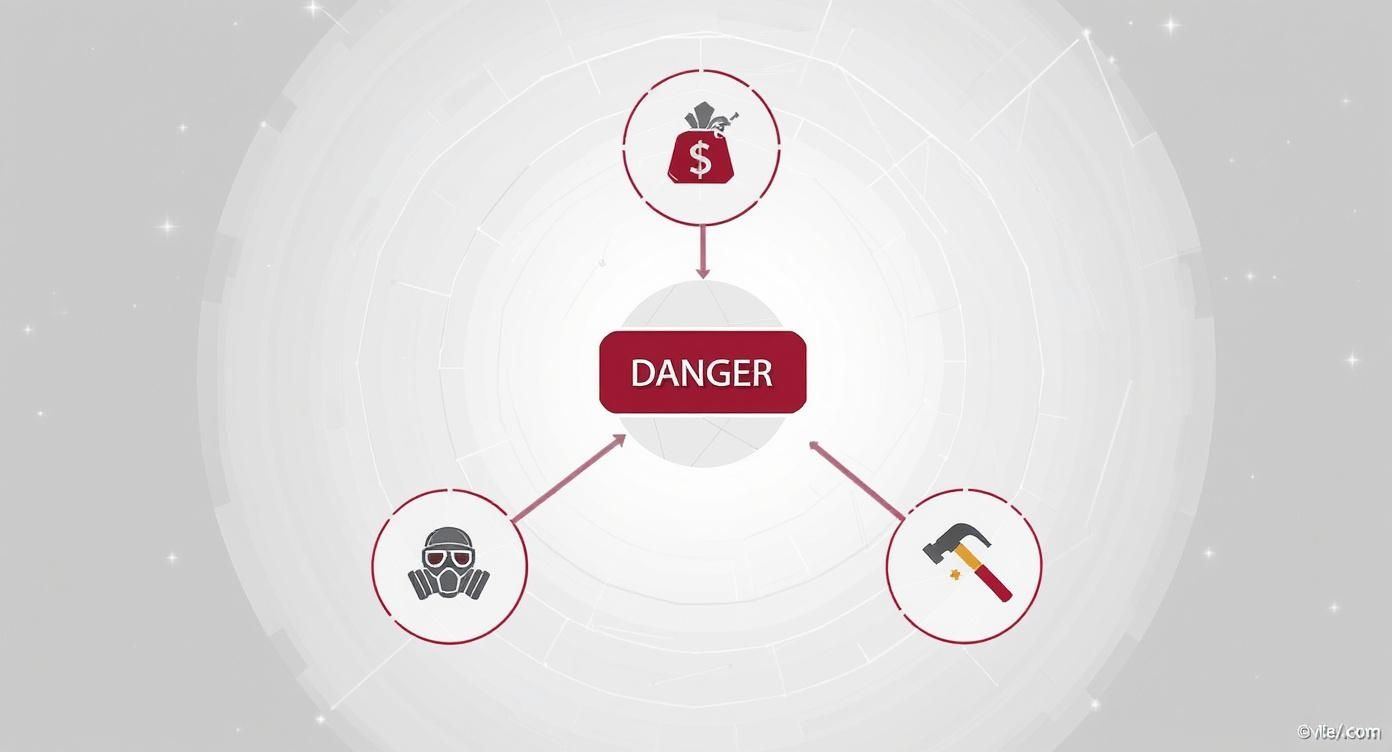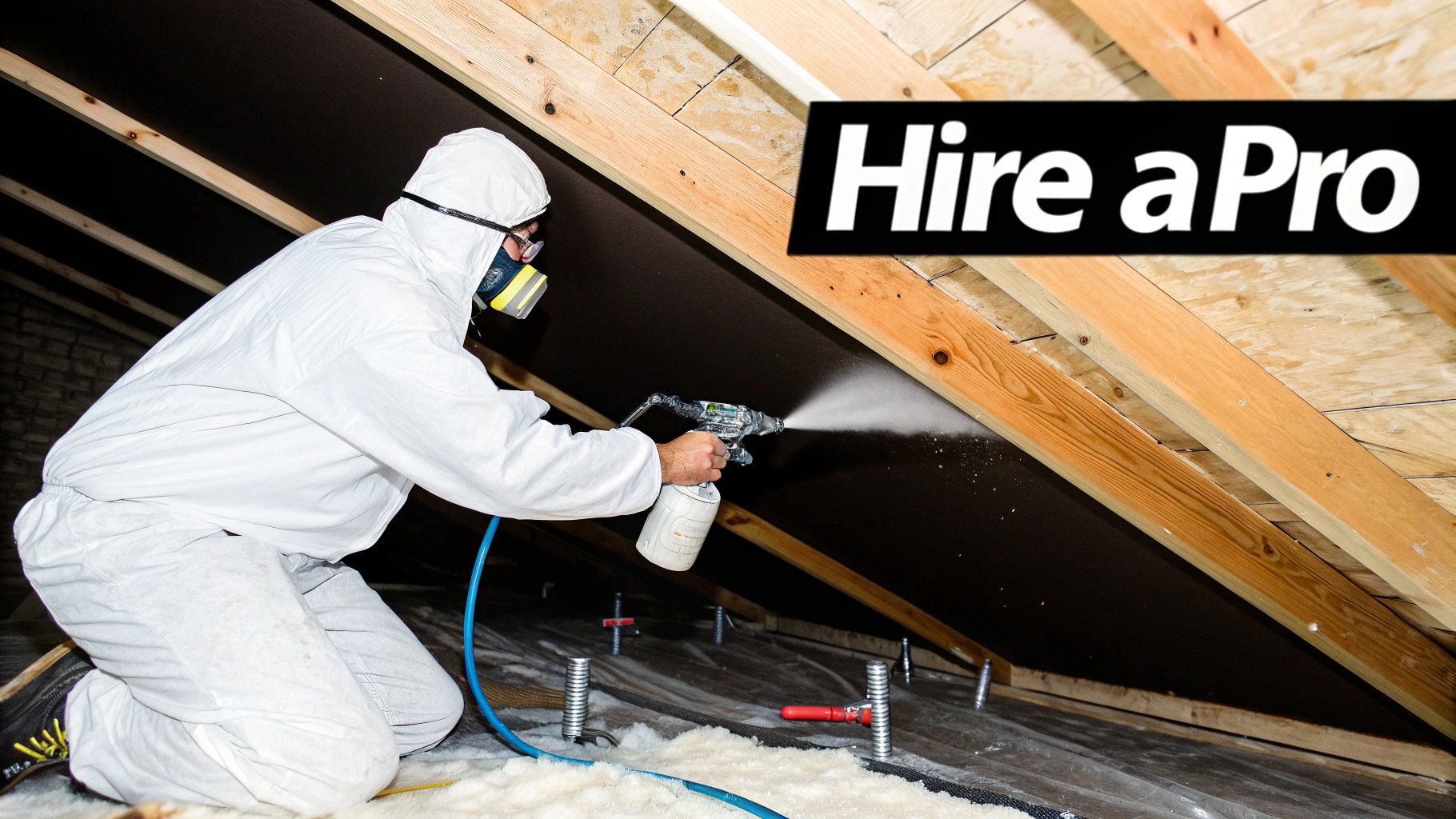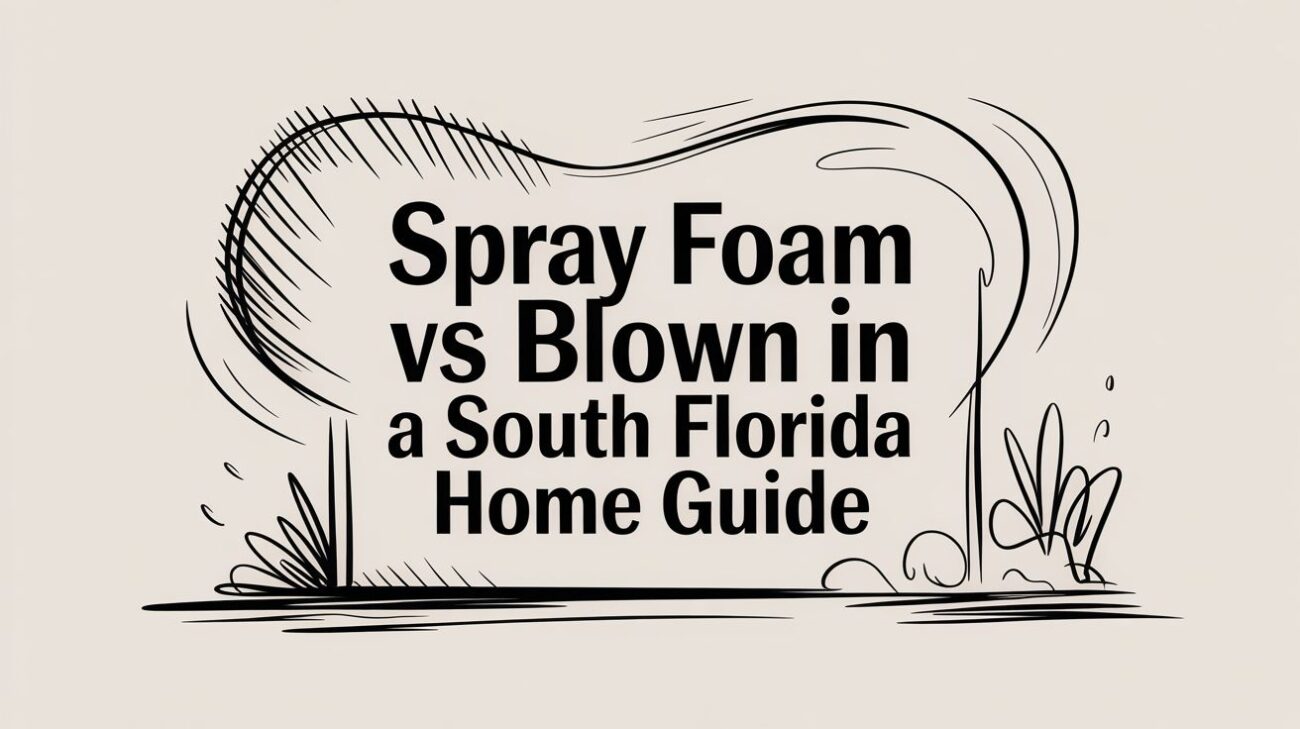Spray Foam Insulation Pros and Cons Guide
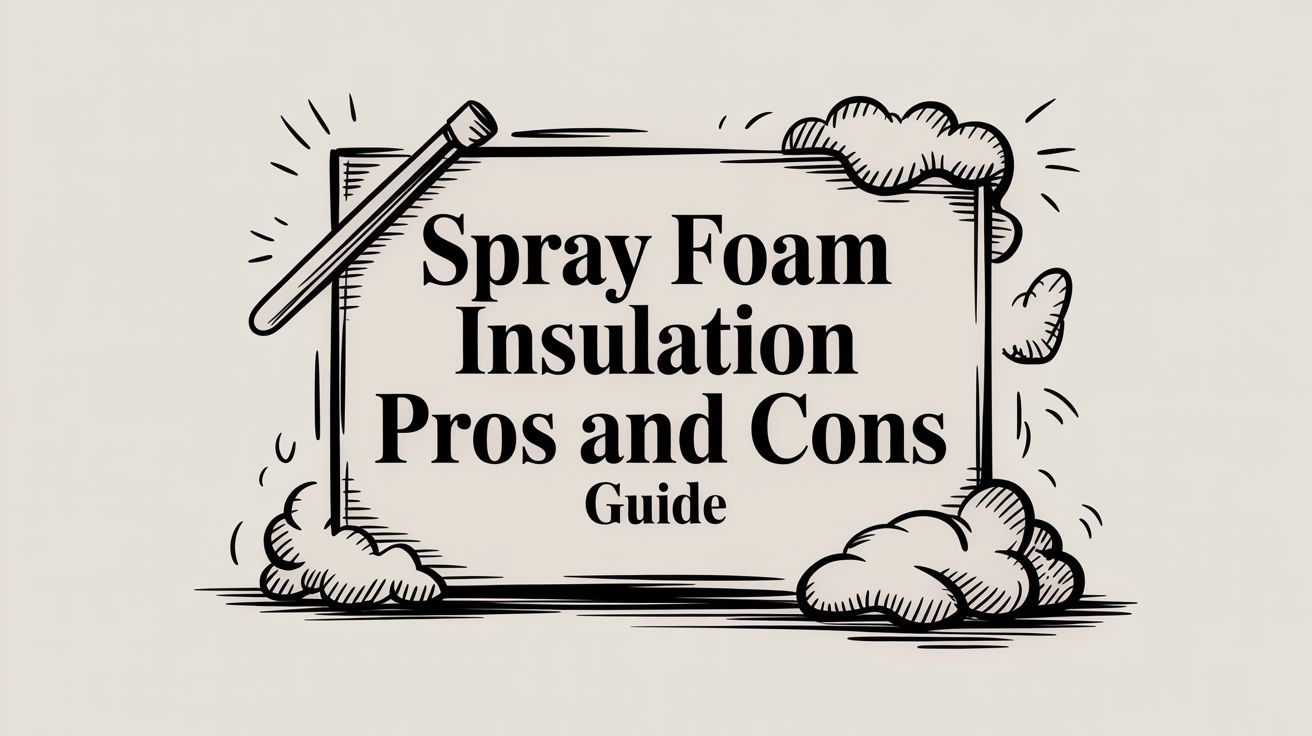
When you're trying to choose the right insulation, it boils down to weighing the pros and cons. With spray foam, the biggest draws are its incredible thermal performance and its knack for creating a truly airtight seal. On the flip side, the main hurdles are the higher upfront cost and the fact that you absolutely need a pro to install it. Getting a handle on this trade-off is the first real step to making a smart call for your property.
A Clear Look at Your Insulation Options
Choosing insulation isn't just about picking the highest R-value you can find; it's a serious investment in your home's comfort, energy bills, and even its structural health for years to come.
Think of it like buying tires. You could go for a basic, budget-friendly set that does the job, or you could invest in high-performance tires that give you better grip, safer handling, and a smoother ride in any weather. Traditional insulation, like those pink fiberglass batts, is the standard option—it's reliable and gets the job done without breaking the bank.
Spray foam? That’s the high-performance upgrade. It doesn’t just insulate; it completely transforms your home's shell into a single, seamless barrier against the outside world. This guide is here to slice through the technical talk and give you a straight, no-nonsense look at spray foam. We'll dig into the good and the bad, so you understand not just what it is, but why it might be the perfect fit for your home, especially here in South Florida's tough climate.
Spray Foam vs Traditional Insulation at a Glance
Let's start with a head-to-head comparison. Here’s how spray foam stacks up against its most common competitor, fiberglass. This quick snapshot really highlights the core differences in how they perform and what they cost.
This table gives you a solid foundation for understanding the trade-offs you're looking at.
| Feature | Spray Foam Insulation | Fiberglass Insulation |
|---|---|---|
| R-Value Per Inch | High (3.5 to 7.0) | Moderate (2.2 to 3.8) |
| Air Sealing | Excellent (forms a complete air barrier) | Poor (allows air to pass through) |
| Moisture Resistance | Good to Excellent (acts as a vapor barrier) | Poor (can hold moisture and support mold) |
| Initial Cost | Higher ($0.75 – $4.50 per square foot) | Lower ($0.40 – $2.50 per square foot) |
| Lifespan | Very Long (often 50+ years) | Moderate (15-30 years before settling) |
| Installation | Professional installation required | DIY-friendly |
Key Insight: The real game-changer isn't just the material—it's how it works. Fiberglass simply resists heat. Spray foam, on the other hand, creates an air barrier that stops heat transfer in its tracks, which is a huge deal since air leakage is one of the biggest sources of energy loss in any home.
As you can see, each has its place. Your job is to figure out which one aligns with your home's needs, your long-term goals, and your budget.
The High-Performance Benefits of Spray Foam
When people ask why spray foam is often considered the gold standard, the answer is simple: it’s not just insulation, it's a complete performance system. While other materials just resist heat, spray foam fundamentally changes how your home breathes, holds its temperature, and deals with moisture. It’s a true upgrade from the old way of doing things.
This level of performance is exactly why the market is booming. The global spray foam insulation market is expected to jump from about USD 2,181.5 million in 2025 to a whopping USD 4,452.1 million by 2035. Why the surge? Because builders and homeowners are catching on to its incredible thermal performance and its unique ability to perfectly seal every last crack and gap. You can get the full scoop on the market's growth over at Future Market Insights.
Unbeatable Thermal Performance and R-Value
The first thing everyone talks about with spray foam is its R-value, which is basically a measure of its thermal resistance. Think of it like a winter jacket. A thin windbreaker gives you a little protection (that's a low R-value), but a serious high-tech parka keeps you warm no matter what (a high R-value).
Traditional insulation like fiberglass batts? That’s the windbreaker. It slows heat down, but it doesn’t really stop it. Spray foam—especially closed-cell—is the high-tech parka, boasting R-values from R-5.5 to R-7.0 per inch.
For your home, that high R-value translates to real-world benefits:
- Rock-Solid Temperatures: Your home stays cooler in the summer and warmer in the winter, and your AC and heater get a much-needed break.
- Lower Energy Bills: When your HVAC system isn’t running constantly just to keep up, you'll see the savings directly on your utility bills.
- Total Comfort: Those annoying hot and cold spots in different rooms? Gone. You get a consistently comfortable living space all year long.
The Bottom Line: A higher R-value means you use less energy to stay comfortable. It’s a win for your wallet and a win for the environment.
Creating a Monolithic Air Barrier
Now, here's where spray foam really pulls away from the pack. Its most powerful feature is its ability to create a seamless air barrier. When our technicians apply it, it goes on as a liquid and expands instantly, filling every tiny crack, gap, and crevice in your walls or attic. Then it cures into a solid, unbroken layer.
This is something traditional insulation just can't do. Fiberglass batts are cut and stuffed between studs, but they leave gaps around pipes, electrical boxes, and framing. These little leaks are a huge problem—they can account for up to 40% of a home's energy loss.
By creating a truly airtight seal, spray foam shuts down:
- Drafts: Those uncomfortable chilly drafts that make a room feel cold are a thing of the past.
- Allergens and Pollutants: Pollen, dust, and other junk from outside have no way to sneak in, which means cleaner indoor air.
- Pests: The foam forms a solid wall that bugs and rodents can't chew through or nest in.
Superior Moisture Control and Structural Integrity
In a place like South Florida, moisture is public enemy number one. Closed-cell spray foam acts as a powerful vapor barrier, blocking humidity from getting into your walls. This is absolutely critical for preventing mold and mildew, which can destroy your home’s structure and cause serious health problems. It’s especially important for insulating concrete block walls, which are notorious for wicking moisture. For a closer look, check out our guide on the insulation value of concrete block.
But there's one more killer benefit: closed-cell foam actually adds structural strength. As it cures, it acts like a high-strength glue, bonding the wall studs and sheathing together. This can increase a wall's racking strength by as much as 300%, making your entire home more rigid and resilient against high winds—something we know a thing or two about in Florida.
Of course, here is the rewritten section with a more human, expert-driven tone, following all the provided guidelines.
Understanding the Potential Downsides and Risks
While the benefits of spray foam are impressive, a genuine look at the spray foam insulation pros and cons means being upfront about the potential downsides. Let's be honest—no insulation is perfect for every single home or building. Spray foam comes with its own set of considerations that every homeowner, contractor, and property manager needs to weigh before making a decision.
The first thing most people notice is the price tag. The upfront investment for spray foam is almost always higher than traditional materials like fiberglass batts or cellulose. This isn't just about the material itself; the cost reflects the sophisticated two-part chemical system and the specialized, high-pressure equipment needed to apply it correctly.
This higher initial outlay is a major factor. While the long-term energy savings absolutely deliver a return on that investment, the budget has to be there to begin with. It firmly places spray foam in the premium category, and it's priced accordingly.
The Necessity of Professional Installation
This is not a weekend warrior project. Unlike grabbing a few rolls of fiberglass from the big box store, installing spray foam is a complex chemical reaction that absolutely requires certified professionals. This isn't just a strong suggestion—it's a critical requirement for both safety and performance. The two chemical components have to be mixed at very specific temperatures and pressures to create the stable, effective foam you’re paying for.
Attempting a DIY job or hiring an inexperienced crew can lead to a whole host of disasters:
- Off-Ratio Application: If the chemical mixture is even a little bit off, the foam might never cure properly. The result? A persistent, unpleasant chemical smell and insulation that barely works.
- Shrinkage and Gaps: An incorrect application technique can cause the foam to pull away from the studs and sheathing as it cures, creating air gaps that completely undermine its air-sealing benefits.
- Poor Performance: At the end of the day, a bad installation means you've paid a premium for a product that performs worse than the cheap stuff. To see how it stacks up against other pro-level options, check out our guide comparing spray foam vs. blown-in insulation.
Health Concerns and Off-Gassing
During the application and the initial curing phase, spray foam releases chemical fumes called Volatile Organic Compounds (VOCs). Exposure to these fumes can cause respiratory irritation, skin issues, and other health problems, which is exactly why professional installers wear full-body personal protective equipment (PPE), including respirators and suits.
For property owners, this means the building must be completely empty during the installation and for a recommended period afterward, usually 24 to 48 hours. Proper ventilation during this time is absolutely crucial to make sure all the off-gassing is finished and the air is safe before anyone re-enters. A lingering chemical smell is a huge red flag that something went wrong with the installation.
Critical Takeaway: Safety during installation is non-negotiable. Always work with a certified installer who follows strict safety protocols and can guarantee a safe re-entry time for your family or tenants.
The Permanent Nature of Spray Foam
Another big factor to think about is just how permanent spray foam is. Once it’s sprayed and cured, it bonds tightly to every surface it touches—studs, sheathing, pipes, and wiring. This is what creates that incredible, durable air seal, but it also makes future renovations or repairs a lot trickier.
Need to access plumbing or run a new electrical line inside a wall that’s been spray-foamed? It's not as simple as pulling out a fiberglass batt. The rigid foam has to be painstakingly cut or scraped away, which is a slow, messy, and labor-intensive job. This "permanence" is a double-edged sword: fantastic for long-term insulation performance, but a real headache for future remodels.
Choosing Between Open Cell and Closed Cell Foam
When you start looking into spray foam insulation, you’ll quickly learn it’s not a one-size-fits-all solution. There are two main players in the game: open cell and closed cell. Each has its own distinct personality and job to do, and picking the right one is the key to getting the performance you expect from your investment.
The easiest way to get your head around the difference is with a simple comparison.
Think of open-cell foam like a soft kitchen sponge. It’s airy, light, flexible, and filled with tiny interconnected bubbles. Now, picture closed-cell foam as a rigid, heavy-duty cooler. It’s dense, hard, and its cells are completely sealed off from each other, which makes it incredibly tough and waterproof.
That one core difference in structure changes everything—from how well it insulates to how much it costs. For us here in South Florida, making the right choice between the two is absolutely critical.
What’s the Real Difference?
So, beyond the sponge and cooler analogy, what do these differences mean for your home? It really boils down to a few key performance metrics.
The most important one is the R-value, which is just a measure of how well the insulation resists heat flow. This is where closed-cell foam really shines, boasting a powerful R-value of R-5.8 to R-7.0 per inch. Open-cell foam comes in with a more moderate, but still effective, R-value of around R-3.6 to R-4.5 per inch.
This visualization really drives home why making a careful choice is so important—the biggest risks with spray foam are almost always tied to the wrong product or a bad installation.
As the graphic shows, things like cost, chemical fumes, and the headache of removal are all major factors. This is why you need a professional who understands which foam to use where.
But R-value is only half the story, especially in our climate. How each foam handles moisture is just as crucial.
- Closed-Cell Foam: With its sealed-cell structure, it’s completely impermeable to water. It acts as its own vapor barrier, which is a massive win in humid environments where stopping moisture is the first line of defense against mold and rot.
- Open-Cell Foam: The sponge-like structure means water vapor can pass right through it. In some wall designs, this is a good thing because it lets the structure "breathe." But if you ever have a roof leak, it can trap that bulk water like a sponge.
Expert Insight: Here in South Florida, humidity is the enemy we fight year-round. Closed-cell foam's ability to double as a vapor barrier isn't just a nice feature—it's a game-changer. It doesn't just insulate; it actively defends your home’s structure from moisture damage.
To help you see the differences at a glance, we've put together a simple comparison.
Comparing Open Cell and Closed Cell Spray Foam
This table breaks down the key characteristics of each foam type, helping you see where one might be a better fit for your project than the other.
| Characteristic | Open Cell Foam | Closed Cell Foam |
|---|---|---|
| R-Value per Inch | R-3.6 to R-4.5 (Moderate) | R-5.8 to R-7.0 (High) |
| Density | Low-density (soft, flexible) | High-density (rigid, strong) |
| Moisture Permeability | Vapor permeable (lets vapor pass) | Vapor impermeable (acts as a barrier) |
| Sound Dampening | Excellent | Good |
| Cost | Less expensive per board foot | More expensive per board foot |
| Structural Rigidity | No | Yes, adds strength to walls and roofs |
| Best Application | Interior walls, attics, soundproofing | Exterior walls, roofs, crawl spaces, basements |
Ultimately, the best choice depends on what you're trying to achieve in a specific area of your home.
Where to Use Each Type of Foam
So, where do you put the sponge and where do you put the cooler? It all comes down to the location and your goals for that space.
We typically recommend open-cell foam for:
- Interior Walls for Sound Dampening: Its soft texture is fantastic at absorbing sound. It’s the perfect choice for home theaters, laundry rooms, or creating a quiet home office.
- Sealing Dry, Protected Attics: In a well-ventilated attic with no history of leaks, open-cell foam is a great, cost-effective way to get an airtight seal and a solid thermal barrier.
Closed-cell foam is almost always the right call for:
- Exterior Walls and Rooflines: Its high R-value and built-in moisture barrier offer maximum protection against South Florida's heat, humidity, and rain.
- Crawl Spaces and Basements: These areas are magnets for moisture. The water resistance of closed-cell foam is non-negotiable here to prevent mold and structural decay.
- Metal Buildings: The rigidity of closed-cell foam adds serious structural strength and completely stops condensation, which is a huge problem in uninsulated metal structures.
At the end of the day, knowing the real-world differences between open-cell and closed-cell foam helps you make a smart, strategic decision that fits both your budget and your home's needs.
Why Professional Installation Is Not Negotiable
When you start digging into the pros and cons of spray foam insulation, one thing becomes crystal clear: this is not a weekend DIY project. Unlike grabbing a few rolls of fiberglass from the hardware store, applying spray foam is a complex chemical process. It demands a serious understanding of building science, requires highly specialized equipment, and involves safety protocols that are far beyond the reach of the average homeowner.
Trying to install spray foam yourself is like attempting your own dental work—you don’t have the right tools, you don't know the proper technique, and the consequences of getting it wrong are both severe and expensive. Hiring a certified, insured professional isn't just a good idea; it's the only way to get a safe, effective, and lasting result.
The Meticulous Application Process
A professional installation is so much more than just pointing a sprayer. It’s a multi-stage operation where every single step is critical to the final outcome. It all starts with thorough site prep, where technicians carefully mask off windows, floors, and anything else that shouldn't get coated. This prevents overspray, a sticky, permanent mess that is next to impossible to clean up.
Then comes the heart of the operation: mixing the chemicals on-site. Spray foam is created when two liquid components are combined at a precise ratio and temperature. This reaction happens inside the spray gun just moments before the foam hits the wall.
- Temperature Control: The chemical drums have to be heated to a very specific temperature range to ensure the reaction works perfectly.
- Pressure Calibration: The rig must maintain consistent high pressure to atomize the liquids and create a fine, even spray.
- Ratio Accuracy: The mixture has to be perfectly balanced. An "off-ratio" spray can result in foam that never fully cures, leaving behind a nasty chemical smell and providing terrible insulation value.
Only certified installers have the calibrated machinery and the hands-on experience to juggle all these variables. This is how you get the stable, inert, and high-performance air barrier you're paying for.
Strict Safety and Curing Protocols
The chemicals used to make spray foam release Volatile Organic Compounds (VOCs) during the application and initial curing phase. This is precisely why professional installers are geared up in full personal protective equipment (PPE), including hazmat-style suits and supplied-air respirators. They also bring in powerful ventilation systems to pull fumes out of the work area, keeping both themselves and your property safe.
Crucial Safety Note: Any reputable installer will insist that the property be completely empty—no people, no pets—for a minimum of 24 to 48 hours. This period allows the foam to fully cure and "off-gas," ensuring the air inside is safe when you return.
An amateur job without these controls can expose everyone in the house to harmful fumes and lead to a dangerously bad application. The risks are huge, from foam shrinking away from the studs to lingering odors and an insulation value that doesn't come close to what was promised. A professional approach, like the one we use in our Airtight Comfort System, guarantees every safety and quality step is followed to the letter.
Vetting Your Insulation Contractor
Before you hire anyone, you need to ask the right questions to protect your investment. A true professional will have no problem giving you straight answers.
- Are you certified and insured? Don't be shy—ask to see their proof of general liability insurance and specific training certifications.
- What experience do you have in South Florida? Local knowledge is everything. Our climate and building codes have unique challenges.
- What brand and type of foam do you use? They should be able to clearly explain why they’ve selected a particular product for your home.
- What is your safety protocol? Make sure they confirm the property must be vacated and that they use proper PPE and ventilation.
- Do you offer a warranty? Get the details on what they guarantee, covering both the foam itself and their installation workmanship.
So, is spray foam the right call for your home?
After looking at the pros and cons, the decision really boils down to your specific home and what you’re trying to achieve. There’s no single answer that fits every property, but if you ask the right questions, you'll land on a choice that makes sense for your goals and budget.
Think of it as a final gut check before you move forward. What’s your main driver? Are you aiming for the lowest possible energy bills and a huge boost in comfort for the long haul, or is the upfront cost your biggest hurdle?
If performance is what you're after, the incredible R-value and air-sealing power of spray foam are hard to beat. But if you’re working with a tight renovation budget, traditional insulation might seem more manageable, even if it means giving up some of those benefits.
A Quick Decision Guide for Homeowners
Your home's unique situation is everything. Let's walk through a few common scenarios to see where spray foam really shines.
-
The Energy-Conscious Family: If your goal is to create the most efficient, comfortable living space you can, spray foam is almost always the best investment. Yes, the initial cost is higher, but the monthly savings on your cooling bills and the improvement in your home's air quality deliver a powerful return. It just feels better to live in a properly sealed home.
-
New Construction Projects: Building a new home? This is the perfect time to install spray foam. It's far easier and more cost-effective to do it from the start, letting you build a high-performance home from the ground up that will hold its value for decades.
-
The Retrofit Renovator: For those of us with existing homes, especially here in South Florida, sealing an old, leaky attic or insulating concrete block walls with closed-cell foam is a game-changer. It directly attacks our region’s two biggest enemies: oppressive heat and sticky humidity.
The Final Verdict: If your checklist includes serious long-term energy savings, next-level comfort, and bulletproof moisture control, spray foam is in a league of its own. Nothing else creates a seamless air barrier quite like it.
At the end of the day, if you’ve decided that these high-performance perks line up with your vision for your property, the next step is pretty clear. The only way to know the exact costs and benefits for your home is to have a professional take a look.
Got Questions? We've Got Answers.
Even after weighing the pros and cons, most people have a few practical questions. It makes sense—you want to know what it’s really like to live with spray foam day-to-day. We get these questions all the time, so let's clear them up.
One of the first things people ask about is the smell. Let's be direct: when professionally installed, any chemical odor from the spray foam should be gone within 24 to 48 hours as it fully cures. We use industrial-grade ventilation during and after the job to make sure of it. A lingering smell is a major red flag that something wasn't mixed right, and it's something a true professional would never leave behind.
Health, Moisture, and Fire Safety
"Will spray foam trap moisture and cause rot?" That's another big one, and the answer comes down to choosing the right tool for the job.
Closed-cell spray foam acts as a vapor barrier, meaning it actively blocks moisture and stops mold in its tracks. Open-cell foam, on the other hand, is vapor-permeable. If it's installed in a damp area without a proper moisture management plan, it could hold water. This is exactly why a professional assessment of your home’s unique situation isn't just a suggestion—it's a necessity.
Finally, what about fire safety? Modern spray foam formulas include flame retardants and are engineered to meet strict building codes. They typically earn a Class 1 fire rating, which is the best you can get, signifying they are slow to ignite.
A Critical Safety Requirement: Building codes are clear on this—spray foam must be covered by a thermal barrier, like drywall. This step is non-negotiable, as it prevents the foam from being directly exposed to a potential flame.
These concerns all point back to one central truth: the quality of the installation is just as important as the quality of the foam itself. A certified pro ensures the right product is used correctly, safely, and effectively for your specific property.
Ready to see how a high-performance insulation system can transform your South Florida property? The team at Airtight Spray Foam Insulation has the experience to deliver a safe, effective, and lasting solution. Request your free, no-obligation quote today and take the first step toward a more comfortable and energy-efficient home.
